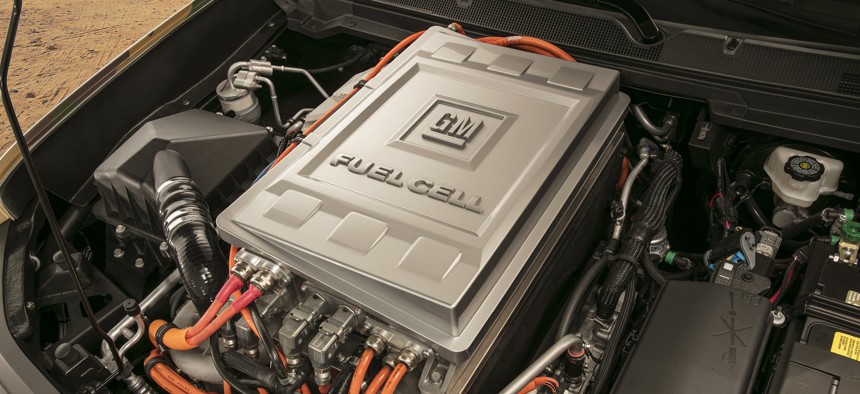
GM plans to unveil a new chassis powered by hydrogen fuel cells like this one introduced in its Chevrolet Colorado ZH2 pickup truck. General Motors
General Motors Wants to Disrupt the Military Truck Market
Building on its hydrogen fuel cell-powered pickup truck for the Army, the automaker will soon unveil a self-powered mobile chassis.
American automaker General Motors has produced a hydrogen-fuel-cell-powered chassis that executives say could allow the U.S. military to move equipment and supplies around the battlefield more efficiently and safely.
Called SURUS, for Silent Utility Rover Universal Superstructure, the vehicle resembles a flatbed truck trailer or even a railroad flatcar. Powered by two electric motors and four-wheel steering, it is designed to be flexible enough to be reconfigured for various missions, powerful enough to replace the trucks that drag heavy things around today’s battlefields, and agnostic about whether it is driven by a human, remote control, or an autonomous driving module.
“We think we can solve real problems for the modernization of the military, not just replacing vehicles that they have now, but making them more efficient, more capable,” Charlie Freese, executive director of GM’s Global Fuel Cell Business, said in an interview this week.
The company plans to unveil SURUS — named for the battle elephant that carried Hannibal and his generals to victory — next week at the Association of the U.S. Army’s annual mega trade show and conference in Washington.
SURUS builds on GM’s Chevrolet Colorado ZH2, a fuel cell-powered version of the commercially available pickup truck produced for an Army experiment. The service is currently testing the ZH2, which was unveiled at last year’s AUSA convention.
Freese said SURUS can be configured for various missions. For example, it could carry a capsule for carrying injured soldiers, or haul large generators airdropped from a C-17 cargo plane or a Chinook helicopter. It could even be armed with guns or rockets. He said this flexibility could reduce the total number of vehicles the Army needs to buy, maintain, and move into a theater of war. Since the chassis is self-propelled, it could even eliminate some of the trucks that tow trailers laden with various items around the battlefield.
Electric drive is also far quieter than internal combustion. “The audible detectability of the vehicle is dramatically better than anything else they have,” Freese said. “They’re basically able to get 10 times closer without being detected.”
GM officials say they have spent some $3.5 billion over the years to develop fuel cells, and are now close to commercializing the technology. The company plans to open a Michigan-based assembly line that will manufacturing fuel cells for a joint venture it has with Honda.
“The idea is that you get fast-charging electric vehicles with zero emissions out of the fuel cell,” Freese said.
The big advantage GM has over the traditional military truck makers: it can recoup the cost of its tech-development efforts by selling to the retail and commercial markets.
“We’re not just doing this for military,” Freese said. “This is part of our electrification strategy for General Motors. We see the future as being a combination of batteries and fuel cells and that’s the pathway that we’re on.”
The goal is ground vehicles that travel 10 times as far as traditional ones on a single “fill-up.” And beyond that, they even see potential for submarines and undersea drones.
“When you start to look at just pieces of the puzzle that are here, there really aren’t too many companies on the planet that can take that combination of technologies and the building blocks and just already have them in the toolbox,” Freese said. “Well, we have them. We’re trying to find a way to leverage them for a combination of military and commercial customers so we can solve those problems.”
NEXT STORY: DHS Forms Election Security Task Force




